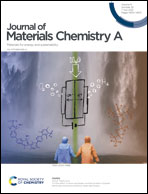Thionated benzo[c]thiophen-1(3H)-one as an organic cathode with high capacity for sulfur-rich all organic lithium-ion batteries†
Abstract
Organic materials have potential advantages in lithium-ion batteries (LIBs) due to their environmental friendliness, flexible designability, and high theoretical capacity. However, the commonly low electrical conductivity and high solubility of conventional organic materials limit their further applications. Herein, we report a novel type of thiocarbonyl material, benzo[c]thiophen-1(3H)-thione (DPTTO), which is based on a thionation strategy by substituting oxygen atoms with sulfur ones in benzo[c]thiophen-1(3H)-one (DPTO). DPTTO displays better comprehensive battery performance than DPTO with an initial specific capacity of 162 mA h g−1 and long-life performance of 80 mA h g−1 at 1 A g−1 after 500 cycles. In situ Raman, ex situ X-ray photoelectron spectroscopy (XPS) and density functional theory calculations are conducted to reveal the lithiation process which occurs between thiocarbonyl and thiophene sulfide. For the sulfur-rich all organic lithium-ion cells, the average capacity is 75 mA h g−1 during 100 cycles (100 mA g−1), which inspires the exploration of sulfur-rich organic materials for future LIBs.
![Graphical abstract: Thionated benzo[c]thiophen-1(3H)-one as an organic cathode with high capacity for sulfur-rich all organic lithium-ion batteries](/en/Image/Get?imageInfo.ImageType=GA&imageInfo.ImageIdentifier.ManuscriptID=D1TA03045K&imageInfo.ImageIdentifier.Year=2021)


 Please wait while we load your content...
Please wait while we load your content...